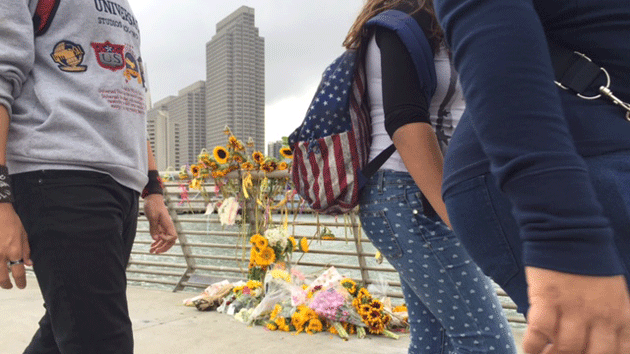
A memorial to Kate Steinle, who was shot last week on San Francisco's Pier 14Josh Harkinson
Indignation continues to mount on the right over the killing of a 32-year-old white woman in San Francisco last week, allegedly at the hands of an undocumented Mexican immigrant. Following the lead of Donald Trump, who last week used the incident to demand tougher immigration enforcement, GOP presidential candidates Jeb Bush and Rand Paul on Wednesday called for an end to “sanctuary city” policies such as the one in San Francisco, which had allowed the alleged shooter, Juan Francisco Lopez-Sanchez, to roam free despite an outstanding federal deportation order.
The tragic particulars of the case seem tailor-made for Fox News. Police say San Francisco resident Kate Steinle was out for an evening stroll with her father on a touristy section of the city’s waterfront when Lopez-Sanchez shot her, seemingly at random. Back in April, he was being held in a San Francisco jail on a 20-year-old drug charge, which a judge ultimately threw out. And although he was wanted by US Immigration and Customs Enforcement, city officials were prohibited by city law from notifying ICE before releasing him. On Monday, Fox’s Bill O’Reilly accused San Francisco’s mayor and county supervisors of being “directly responsible for the murder” and called on the federal government to compel cities to enforce immigration law.
But there’s a reason sanctuary city laws are so popular, with more than 200 state and local jurisdictions refusing to honor ICE detention requests. Evidence suggests that these laws don’t just make cities safer for illegal immigrants; they make them safer for everyone.
Take San Francisco. If the GOP candidates are to be believed, then we should have seen a rise in San Francisco’s murder rate in the 26 years since it enacted its sanctuary law, and a further spike since 2013, when the city amended the law to cover even repeat felons such as Lopez-Sanchez. Instead, the city’s murder rate has fallen to its lowest level in decades:
We’re seeing a similar phenomenon throughout California. According to a Department of Justice report released last week, the number of homicides in the state fell to to 1,691 last year, the lowest since 1971. Meanwhile, the state legislature and all but a few counties have enacted sanctuary laws, though they vary in the sorts of protections offered.
It’s worth noting that crime has fallen nationwide in recent years, but San Francisco’s murder rate is also low compared to that of comparable cities that don’t have sanctuary policies:
Crime rates alone aren’t enough to prove that sanctuary laws make us safer, but other evidence suggests the effect on public safety is real. A 2013 study by the Department of Urban Planning and Policy at the University of Illinois-Chicago surveyed Latinos in Chicago, Houston, Los Angeles, and Phoenix. It found that the increased involvement of local police in immigration enforcement in those cities had eroded trust in the legal system among both legal and illegal immigrants. Of those surveyed, 38 percent said they felt like they were under more suspicion and 45 percent said they were less likely to report a crime as a result—70 percent of the undocumented immigrants said so. The erosion of trust was felt most acutely in Phoenix, where Maricopa County Sheriff Joe Arpaio has put strict immigration enforcement at the center of his agenda.
Law enforcement interests take such concerns seriously. A 2009 report published by the Police Foundation found that “local police involvement in immigration enforcement could have a chilling effect on immigrant cooperation” with police. “Without this cooperation, law enforcement will have difficulty apprehending and successfully prosecuting criminals, thereby reducing overall public safety for the larger community.”
Sanctuary laws may also help cities prevent crime by attracting more immigrants. According to an analysis of census data published last week by the Immigration Policy Center, immigrants are less likely to commit crimes than native-born citizens—1.6 percent of immigrant men between the ages of 18 and 39 are incarcerated, compared to 3.3 percent of men who were born here. Even among young, less-educated Mexican, Guatemalan, and Salvadoran men who make up the bulk of the foreign-born prison population, the incarceration rate is much lower than that of native-born men who lack a high-school diploma.
Does all of this mean sanctuary laws will always work as intended? The killing of Kate Steinle suggests otherwise. But on balance, the data shows that they are more likely than not to improve public safety.
















